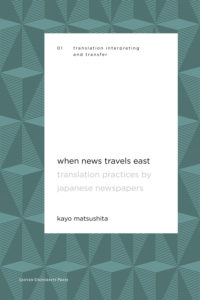[New Publication] When News Travels East Translation Practices by Japanese Newspapers
 When News Travels East: Translation Practices by Japanese Newspapers
When News Travels East: Translation Practices by Japanese Newspapers
Journalism and unique translation practices by Japanese media today
International news stories provided to the public basically rely on translation. Most of this translation is done not by translators, but by journalists with practically no training in translation. What happens when the norms of journalism and those of translation clash? In this book, the author, a trained conference interpreter and former international journalist, investigates translator decisions in the practice of Japanese news translation. Her extensive analysis of texts from six major Japanese newspapers and interviews with Japanese “journalators” focuses on direct quotations, where accuracy is a journalistic priority but can generate loss of communication impact if implemented rigidly. She argues that many shifts from accuracy can be explained as risk management strategies. When News Travels East provides invaluable insight from an insider about news translation in Japan and beyond and paves the way for further research in the field.
This publication is GPRC-labeled (Guaranteed Peer-Reviewed Content).
About the author
Kayo Matsushita is associate professor of Interpreting and Translation Studies at Rikkyo University and board member of The Japan Association for Interpreting and Translation Studies.
Table of Contents
List of Tables
List of Figures
Preface
Chapter 1. Introduction
1.1 Everywhere and Nowhere: Defining the Boundaries of News Translation
1.2 Scope and Purpose
1.3 Case and Framework
Chapter 2. What is News Translation?
2.1 Journalism and Translation
2.1.1 Gatekeeping and Transediting
2.1.1.1 Gatekeeping
2.1.1.2 Transediting
2.1.2 Research by Insiders
2.1.3 Warwick’s “Translation in Global News” Project
2.1.4 News Translation Research in Japan
2.2 Journalism and Speech Events
2.2.1 Direct Quotations
2.2.2 Translation of Speech Events
Chapter 3. Japanese Journalism and Translation
3.1 Historical Development
3.2 The Current Media Landscape
3.2.1 Newspapers
3.2.1.1 The Yomiuri Shimbun (読売新聞)
3.2.1.2 The Asahi Shimbun (朝日新聞)
3.2.1.3 The Mainichi Shimbun (毎日新聞)
3.2.1.4 The Nikkei (日本経済新聞)
3.2.1.5 The Sankei Shimbun (産経新聞)
3.2.1.6 The Chunichi Shimbun (中日新聞)
3.2.2 Magazines
3.2.3 TV Broadcasting
3.2.4 Radio Broadcasting
3.2.5 Online Media
3.3 Japanese Journalators
3.3.1 Overview
3.3.2 Typical Profiles
3.4 The News Translation Process
Chapter 4. Risk Management in Translation
4.1 What is Risk in Translation?
4.2 Pym’s Concept of Risk Management
4.2.1 Uncertainty and Translation
4.2.2 The Nature of Risk
4.2.3 Effort and Risk
4.2.4 Ethics and Risk
4.2.5 Translation Strategies as Risk Management
4.3 Particular Risks in News Translation
Chapter 5. Analyzing the Effect of Risks on Translation
5.1 Methodologies in News Translation Research
5.2 Risk Analysis
5.2.1 Designing the Method
5.2.2 Categorizing the Risks
5.2.3 A Model for the Analysis of Risk in News Translation
5.2.3.1 Step One: Selecting the Target
5.2.3.2 Step Two: Identifying the Translation Strategies
5.2.3.3 Step Three: Analyzing the Strategy and Effort
5.2.3.4 Step Four: Identifying and Analyzing Risk Management
Chapter 6. Case Study: 2012 U.S. Presidential Election
6.1 Difference in Quoting Obama and Trump
6.2 Targeted Speech Events
6.2.1 Victory Speech
6.2.2 Inaugural Address
6.2.3 Journalators’ Roles 9
6.3 Text Analysis
6.3.1 Types of Strategies
6.3.1.1 Omission
6.3.1.2 Addition
6.3.1.3 Substitution
6.3.1.4 Distribution of Omission, Addition, and Substitution
6.3.2 Qualitative Analysis
6.3.2.1 Omission as a Key Strategy
6.3.2.2 Examples of Addition
6.3.2.3 Examples of Substitution
Chapter 7. News Translation Practices in Various Genres
7.1 Unethical and Non-Standard Practices
7.1.1 Comparing Interlingual and Intralingual Practices
7.1.2 Applying a New Concept
7.2 How Risk Affects the Translator’s Decision-Making Process
7.2.1 Journalator Profile: Keiichi Shirato
7.2.2 Accuracy in Translation
7.2.3 Time and Space Limitations
7.2.4 Effects of Risk
7.3 Preliminary Conclusion
Chapter 8. News Translation and the Changing Media Environment
8.1 New Types of Risks and Coping Methods
8.1.1 Managing Risk in a Press Conference
8.1.2 Managing Risk through Double-Presentation
8.1.3 Managing Risk through Increased Visibility
8.2 News Translation Research in an Advanced Information Society
Afterword
Appendices
A. The White House Transcript of President Obama’s Remarks on Election Night delivered November 7, 2012
B. The White House Transcript of President Obama’s Inaugural Address delivered January 21, 2013
Notes
References
Index
